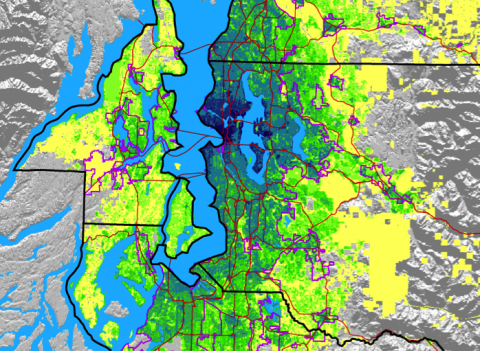Discussion:
Indexes take on a market theory notion that the efficient frontier has all the information needed to calculate an accurate return (reward) versus risk (cost) index. Following this notion is the idea that filtering the market for certain criteria of a specialized index lowers the amount of return received for risk taken, because filtered information is inefficient. This raises questions about the efficiency of markets because active managers filter economic information everyday to create specialized portfolios to increase return. On this, it would theoretically stand that an index measuring the well being of society could filter for criteria rewarding the common good with little to no ill effect from lack of the so called efficiency imbibed by the market.
Around the globe, there is an increase in the number of sustainability and social responsibility indexes (SRI). These indexes came out of first generation socially conscious investing that excluded corporate stock from investment portfolios on the basis of particular activities deemed to be unethical. From this, a second generation has emerged and the focus of SRI has changed primarily to identifying social and environmental issues that are material to business performance. This is an increased attempt by companies to assess the materiality of sustainability issues on (stock) value creation. These indices paint a picture that socially responsibility is only important when a financial gain is made by corporations or stockholders. This is not exactly what we are looking for when we hope to use indexes to help measure the well being of our world. When individual investors purchase SRI traded securities/indexes they still have to deal with the reality that the costs to living capital are making life less valuable even while their portfolios grow.
Gross Domestic Product (GDP)/Gross National Product (GNP) per capita has most lately been used as an index of standard of living in an economy. GDP/GNP only measures the populations ease in satisfying their material wants (an index of reward for risk taken) and all else that contributes to the sustainability of people and the environment is lost. "Adding up the monetary transactions in an economy and calling this prosperity obscures an honest account of the well being of nations." (Anielski, 2000)
Quality of life and standard of living should not be separate measurements in an index "A more complex index of standard of living than GDP must be employed to take into account not only the material standard of living but also other factors that contribute to human well-being such as leisure, safety, cultural resources, social life, mental health, and enironmental quality issues, to name a few." (Anielski, 2000)
Simon Kuznets' idea
[in] favour of more inclusive measures, less dependent on markets..." (Anielski, 2000) rings true as a more realistic approach to well-being. "The eventual solution would obviously lie in devising a single yardstick of both economies [virtual wealth money,debt, stock markets; and real wealth human, natural and social capital]
that would perhaps lie outside the different economic and social institutions and be grounded in experimental science (of nutrition, warmth, health, shelter, etc.)." (Anielski, 2000) The business for this millennium is to take up this empirical economic challenge for a single bottom line index for national well-being.
The U.S. Genuine Progress Indicator (GPI) and its predecessor, the Index for Sustainable Economic Welfare (ISEW) provide the basis for developing a new accountancy to address Kuznets challenge. The U.S. GPI released in 1995 and since updated
is one of the most ambitious attempts at calculating the total benefits and costs related to [economics for community] for the US. First developed by Clifford W. Cobb, GPI/ISEW remains one of the most important attempts to measure sustainable current welfare." (Anielski, 2000)
"The GPI adds a cost side to the growth ledger, begins to account for the aspects of the economy that lie outside the realm of monetary exchange, acknowledges that the economy exists for future generations as well as for the present one and adjusts for income disparities. The GPI begins with personal consumption expenditures as a baseline, the way the GDP does. Personal spending by households makes up roughly 65 percent of the US GDP. The GPI then make a series of 24 adjustments for unaccounted benefits, depreciation costs (for social and natural capital) and deducts regrettable social and environmental expenditures. Specific elements of the GPI include personal consumer expenditures, income, value and cost of consumer spending on durable goods and household capital, cost of household pollution abatement, cost of commuting, cost of crime, cost of automobile accidents, cost of family breakdown, value of housework and parenting, value of voluntary work, loss of leisure time, services of streets and highways, cost of underemployment, air pollution, ozone depletion, water pollution, noise pollution, cost of depletion of non renewable, loss of forests, long term environmental damage, loss of wetlands, net capital investment, net foreign lending/borrowing." (Anielski, 2000) The GPI has also set goals for itself "to improve its framework in the areas of human capital, technology, government spending, social infrastructure, natural capital and environmental accounts, ecological carrying capacity, genetic diversity, water projects, workplace environment, underground economy, and pollution and lifestyle induced disease." (Anielski, 2000)
The results of the GPI reveal that "
well being has declined while virtual wealth (debt, stock markets) have grown exponentially. One could say that while we are making more money we are effectively eroding the living capital which makes our lives worthwhile. The primary benefit of the GPI is to provide decision makers with a more holistic account of the economic well-being of their community
." (Anielski, 2000)
"Any accounting system of well-being must be aligned with the values, experiences, and physical realities of the citizens of a community. The challenge in future GPI/ISEW accounting will be the ability of constructing accounts that are consistent with the held values, principles, and ethical foundation of a community or society." (Anielski, 2000)












